I was fortunate to grow up playing games like Monopoly, Scrabble, and Battleship…just to name a few. I’ve recently realized however that a lot of those classic board games would look relatively new to an eleven year old. I looked in stores to try and find a newer print of the board game Clue, but the version I tended to find had revamped the weapons and characters…it was almost as if I had come across a Clue: 90210 variant. I’m not going to knock it since I haven’t played it, but I instead chose to order the classic edition from Amazon and keep with the characters and weapons that I remember.
Clue: The Classic Edition is a murder mystery game that takes place inside of Mr. Boddy’s mansion. Mr. Boddy, as bad luck would have it, was murdered. Players are tasked with finding out the Who, What, and Where of the murder. The first person to formally announce the suspect, weapon, and room correctly wins the game. Let’s take a quick look at the components and gameplay before heading into the review.
Components
The Board – The board (Mr. Boddy’s mansion) is made up of nine rooms, all of which represent possible places where the crime took place.
Player Tokens – There are six suspects and each one is represented by a particular color. Players will each be assuming control of one throughout the game.
Weapon Pieces – There are six weapons that players will be moving around the board as they make suggestions on how the crime was carried out.
Cards – There are twenty-one cards, one of each representing the suspects, weapons, and rooms in the game.
Detective Notebook – Each player will receive one and use it to eliminate suspects, weapons, and rooms as possible particulars of the crime.
Setup & Gameplay
Players will place all six suspects on the board on their start spaces and assume control of one of them. The weapon pieces are randomly placed in various rooms. The suspect, weapon, and room cards are separated into separate decks and shuffled individually. One of each is placed inside the yellow confidential envelope…these cards serve as the answer to the who, what, and where of the crime, so no peeking! The three decks are then shuffled together and dealt to players as equally as possible.
The first thing players will want to do is mark off on their detective sheets which cards they have in their hand…since you have them, they therefore cannot be inside the envelope.
Players will be taking turns rolling the die, moving their suspect around the board. When suspects enter a room, their movement ends, but they get to make suggestions and if they are ready to, an accusation.
When making a suggestion, the current player will announce a suspect, a weapon, and the room they are currently in. The player to the left then must disprove the suggestion by showing the current player a matching card. If the player on the left has more than one matching card, they then get to pick one which one to show the current player. If the player on the left does not have a matching card, then the next player can show the current player one, if they have it. Showing cards must remain private between the two players involved and no one else.
After a suggestion is complete, the current player can eliminate that card on their detective notebook and make an accusation, if they wish. To make an accusation, the current player must announce it along with the particulars of the crime, and then look inside the yellow envelope. If they guessed correctly, they win. Accusations are a one-time deal…if you guess wrong; you are eliminated from the game.
I won’t recite the manual, but the above should give you an idea of what you are in for. The manual can be found here: Clue: The Classic Edition Manual.
The Review
With all of the complex games I’ve been reviewing recently, I found myself happy to be writing about one that didn’t require that much brain power. Sure, there is some strategy in suggesting the right cards to eliminate particulars, but I didn’t have to worry remembering my opponent’s special power before an attack or whether or not I stocked pile X in phase three sub c paragraph nine.
Clue: The Classic Edition is just how I remember it, with the exception of the pieces being slightly different (the gun, for one). I’ve always enjoyed deductive reasoning and the thrill of opening that envelope to see if I was right in my logic. I’m happy to say that the moment of truth adrenaline rush hasn’t totally escaped me after all of these years.
This was my son’s first time playing, Clue. I got the impression based on his facial reactions that he thought the game was fun to play. I took enjoyment out of watching the gears inside his little mind work as he checked off suspect, weapons, and rooms on his detective sheet. Vinnie Jr commented afterwards that he enjoyed trying to figure out the answer. I had to remind him on a regular basis to stop showing his cards…he often tends to forget to hide them, though it was no big deal.
Anthony Jr, the sixteen year old, liked the fact that it was a game that I used to play as a kid. We are often used to pausing during our game reviews to look at the rules, but we didn’t have to do that this time around. I caught Anthony making suggestions on suspects and weapons he’d previously asked for (and got the answer to) in order to eliminate items in other categories. I could tell he was really getting into it.
If you’re on the fence as to whether or not your family would enjoy playing this game on family game night, I recommend that you think about it no more and take the plunge. It’s quick, it’s semi-easy, and still loads of fun after all of these years.
Final Verdict: 8/10

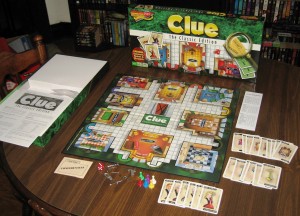
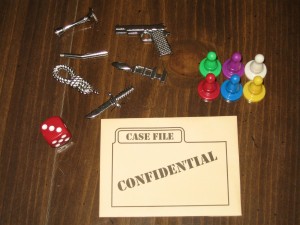
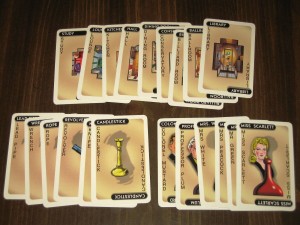
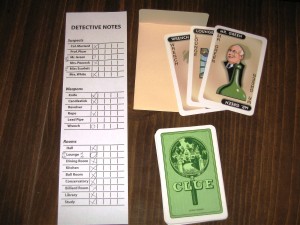
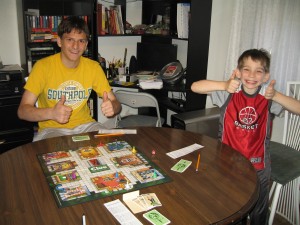
Thank you. I didn’t get to play clue when I was a kid. We only had Monopoly and Yahtzee. I am going to get this classic clue game. Do you have suggestions for 2 person board games? It is just my 11 year old grandson and myself.